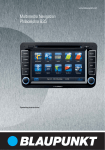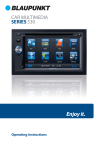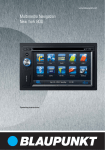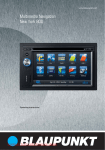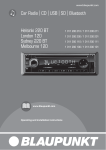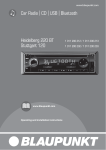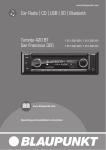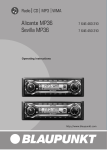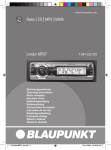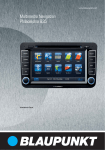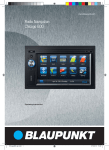Download Blaupunkt New York 830 Operating instructions
Transcript
www.blaupunkt.com Multimedia Navigation New York 830 New York 835 Operating instructions Controls – Device 1 14 2 13 3 4 5 12 6 7 8 11 9 10 1 button (Eject) Eject a CD/DVD 2 MENU button Short press: Call up main menu In the main menu: Call up menu of active source Long press: Call up Bluetooth® function or switch off display. Function can be selected in the settings menu. 3 MAP button Short press: Call up navigation In navigation mode: Call up menu of active source Long press: Call up display brightness setting 6 Infrared receiver for remote control 7 Reset button Restoring the original factory settings of the device. Caution! All personal settings will be lost! 8 Cover 9 SD card reader Access only with open cover : Front AV-IN socket (source AV-IN 1) Access only with open cover ; Front USB socket (source USB 1) Access only with open cover 4 Microphone < Touchscreen user interface 5 Rotary/pushbutton = MicroSD card reader for navigation data Short press: Switch on device In operation: Mute audio source Long press: Switch off device Turn: Adjust volume 2 Access only with open cover > DVD/CD drive Controls – Remote control 15 44 16 43 17 42 18 41 19 40 20 39 21 38 22 37 23 36 G RPT A-B button Define range for repeat function H RPT button Repeat function I SETUP button Call up settings menu J button Start and interrupt playback Confirm settings K / / / button Navigate in menus and change settings Tuning into stations manually ( / ) Starting station seek tuning ( / ) L button Slow-motion playback 24 35 25 26 34 27 33 28 32 M Number buttons 0 - 9 31 29 30 N / MIX button Random track play O / SCN button Scan function P MUTE button Mute audio source Q button Quit playback R VOL + / – button Adjusting the volume S PIC button Screen settings ? SRC button Call up main menu @ / EJECT button Eject a CD/DVD A AUDIO / MUSIC button Select playback language (if available on DVD) Call up folder overview of audio files T / button Select title, chapter, movie Fast searching U button Ending/rejecting a phone call V CLEAR button Delete last character of an entry W TITLE button Call up title and chapter list X MENU button Call up DVD menu Y ANGLE / VIDEO button Select camera viewing angle (if available on DVD) Call up folder overview of movies B DISP button Show information on the display C ZOOM button Z SUBTITLE / PHOTO button Select subtitle language (if available on DVD) Call up folder overview of images Zoom in on image area D BAND button Select waveband/memory bank E button Answer a call [ button Switching device on/off \ EQ button Call up equaliser menu F GOTO button Directly select title, chapter, movie or playtime 3 Contents Safety notes ................................................................ 5 Symbols used ...........................................................................5 Road safety ................................................................................5 General safety notes ..............................................................5 Declaration of conformity....................................................5 Cleaning notes ............................................................ 5 Disposal notes............................................................. 5 Scope of delivery ........................................................ 6 Placing the device in operation ................................. 6 Theft protection ......................................................................6 Switching on/off......................................................................6 Volume ........................................................................................6 Main menu ................................................................................6 Radio mode ................................................................. 7 Start radio mode .....................................................................7 Select memory bank ..............................................................7 Tuning into a station ..............................................................7 Storing stations manually ....................................................7 Storing stations automatically (Travelstore) .................7 Scanning stations....................................................................7 Switching RDS on/off ............................................................7 Switching RDS time signal on/off .....................................8 Optimising radio reception .................................................8 Switching the REG function (regional programmes) on/off ..............................................................8 Switching the AF (alternative frequencies) function on/off.........................................................................8 Adjusting the seek tuning sensitivity ..............................8 Traffic information ..................................................................8 Navigation................................................................... 9 Loading navigation data ......................................................9 Download of map data .........................................................9 Starting the navigation .........................................................9 Initial startup ............................................................................9 Entering a destination ...........................................................9 Address ......................................................................................9 Points of Interest ................................................................. 10 Setting route options ......................................................... 11 Map Settings.......................................................................... 12 DVD/CD/USB/SDHC/iPod media playback ............. 13 Basic information ................................................................. 13 DVD/CD mode ...................................................................... 13 USB data carrier .................................................................... 13 SDHC cards ............................................................................. 14 iPod/iPhone via USB ........................................................... 14 DVD movie playback .......................................................... 14 4 Audio playback of DVD/CD, USB, SDHC or iPod/iPhone ........................................................................... 15 Video playback from DVD/CD, USB or SDHC ............. 16 Image playback from DVD/CD, USB or SDHC ............ 16 Bluetooth mode ........................................................ 17 Starting Bluetooth mode .................................................. 17 Registering Bluetooth devices ........................................ 17 Telephone mode - Bluetooth........................................... 17 Audio playback - Bluetooth.............................................. 18 Bluetooth settings ............................................................... 18 Rear Seat Entertainment (RSE) ................................ 19 External audio/video sources .................................. 19 Sound settings .......................................................... 20 Volume distribution (fader/balance) ............................ 20 Equalizer .................................................................................. 20 Basic settings ............................................................ 20 Video......................................................................................... 20 General .................................................................................... 21 Time .......................................................................................... 21 Sound ....................................................................................... 21 Language ................................................................................ 22 Bluetooth ................................................................................ 22 DVD ........................................................................................... 22 Volume ..................................................................................... 22 Useful information ................................................... 23 Warranty .................................................................................. 23 Service...................................................................................... 23 Connection diagram ................................................ 24 Appendix ................................................................... 25 Safety notes | Cleaning notes | Disposal notes Safety notes The car sound system was manufactured according to the state of the art and established safety guidelines. Even so, dangers may occur if you do not observe the safety notes in these instructions. These instructions are intended to familiarise you with the most important functions. Detailed information can be found on the Internet under www.blaupunkt.com. • Read these instructions carefully and completely before using the car sound system. • Keep the instructions at a location so that they are always accessible to all users. • Always pass on the car sound system to third parties together with these instructions. In addition, observe the instructions of the devices used in conjunction with this car sound system. Symbols used These instructions employ the following symbols: DANGER! Warns about injuries CAUTION! Warns about damages to the DVD/CD drive • Always listen at a moderate volume to protect your hearing and to be able to hear acoustic warning signals (e.g. police sirens). During mute phases (e.g. when changing the audio source), changing the volume is not audible. Do not increase the volume during this mute phase. General safety notes Observe the following note to protect yourself against injuries: Do not modify or open the device. The device contains a Class 1 laser that can cause injuries to your eyes. Use as directed This car sound system is intended for installation and operation in a vehicle with 12 V vehicle system voltage and must be installed in a DIN slot. Observe the output limits of the device. Repairs and installation, if necessary, should be performed by a specialist. Installation instructions You may only install the car sound system yourself if you are experienced in installing car sound systems and are very familiar with the electrical system of the vehicle. For this purpose, observe the connection diagram at the end of these instructions. Declaration of conformity DANGER! Warns about high volume The CE mark confirms the compliance with EU directives. 쏅 Identifies a sequencing step • Identifies a listing Road safety Observe the following notes about road safety: • Use your device in such a way that you can always safely control your vehicle. In case of doubt, stop at a suitable location and operate your device while the vehicle is standing. As the driver, you may not use the applications that will distract you from traffic (depending on the scope of functions of the device, e.g. viewing videos, entering a destination). • Follow the driving recommendations during the route guidance only if you are not violating any traffic regulations! Traffic signs and traffic regulations have always priority over driving recommendations. The Blaupunkt Europe GmbH declares that the devices New York 830 and New York 835 comply with the basic requirements and the other relevant regulations of the directive 1999/5/EC. The declaration of conformity can be found on the Internet under www.blaupunkt.com. Cleaning notes Solvents, cleaning and scouring agents as well as dashboard spray and plastics care product may contain ingredients that will damage the surface of the car sound system. Use only a dry or slightly moistened cloth for cleaning the car sound system. Disposal notes Do not dispose of your old unit in the household trash! Use the return and collection systems available to dispose of the old device, the remote control and exhausted batteries. 5 Scope of delivery | Startup Scope of delivery The scope of delivery includes: • New York • Remote control (incl. battery) • TMC Tuner (not for 1 011 203 821/831) • MicroSD card with navigation data in the MicroSD card slot (only for devices with navigation) • GPS antenna • External Bluetooth microphone • Getting started • Support frame • Small parts set • Installation material • Connecting cable Placing the device in operation Caution! Transport securing screws Ensure that the transport securing screws are removed before the startup of the device. Theft protection This car sound system is protected against theft with a four-digit code number (code number is factory-set to 0000). If the code query is activated, the code number must be entered after every interruption of the power supply from the vehicle battery. Note: In the General submenu of the settings menu, you can activate/deactivate the code query and change the code number. 쏅 Press the [ ] button to confirm the entry. The device is switched on. Note: If you entered an incorrect code number, the display briefly shows Security code incorrect!. Afterwards, you can repeat the code entry. Switching on/off Switching on/off with the rotary/pushbutton 쏅 For switch-on, press the rotary/pushbutton 5. 쏅 For switch-off, hold the rotary/pushbutton 5 pressed for more than 2 seconds. Switching on/off via vehicle ignition If the car sound system is connected with the vehicle ignition and it was switched off with the rotary/pushbutton 5, it is switched on or off with the ignition. Volume Adjusting the volume You can adjust the volume in steps from 0 (off ) to 50 (maximum). 쏅 Turn the rotary/pushbutton 5 to change the volume. Muting the car sound system (Mute) 쏅 Briefly press the rotary/pushbutton 5 to mute the device or to reactivate the previous volume. Main menu In the main menu, you press the buttons on the touchscreen to call up the different sources and operating modes. 쏅 Press the MENU button 2. The main menu is displayed. Entering the code number after a voltage interruption If the code number is required, a keypad for entering the code number is displayed. 쏅 Enter the code number via the keypad. As long as you do not select a new audio source, the last active audio source is played back. Note: The figures used in these instructions are intended to facilitate the explanations and details may deviate from your device. 6 Radio mode Radio mode Start radio mode 쏅 In the main menu, press the Radio button. The radio menu is displayed. Storing stations manually 쏅 Select the desired memory bank with the [ ] button. 쏅 Set the desired station. 쏅 Press the [ ] button. The menu for storing stations is displayed. 6 memory locations are available that are displayed as buttons. 쏅 Press the button under which you want to store the current station. The station is stored, the radio menu is displayed again. Storing stations automatically (Travelstore) Select memory bank Different memory banks and wavebands are available. Up to 6 stations can be stored in each memory bank. 쏅 Press the [ ] button repeatedly until the desired memory bank is displayed. Tuning into a station Tuning into stations manually 쏅 Briefly press the [ ] or [ ] button once or several times to change the frequency in increments. Enter broadcast frequency directly If the frequency of the desired stations is known, it can be entered directly via the touchscreen. 쏅 In radio mode, press the [ ] button. A numeric keypad is displayed for the frequency input. 쏅 Enter the frequency of the desired station with the numeric keypad. 쏅 Press the [ ] button. The radio menu is displayed, the station of the frequency entered is played back. Starting station seek tuning ] or [ ] button for approx. 2 seconds 쏅 Press the [ to start station seek tuning. The radio tunes into the next receivable station. Note: For the reception area Europe: In the FM waveband, only traffic information stations are tuned into if the priority for traffic information is switched on. With Travelstore, you can automatically search for and store the 6 FM stations offering the strongest reception in the region in the memory bank FM1, FM2 or FM3. 쏅 Select an FM memory bank. 쏅 In the radio menu, press the [ ] button. 쏅 In the options menu, press the Travelstore button. The tuner starts the automatic station seek tuning. After the storing is completed, the radio plays the station at memory location 1 of the previously selected memory bank. Note: For the reception area Europe: With switched-on priority for traffic information, only traffic information stations are stored. Scanning stations You can use the scan function to play all the receivable stations of the current waveband for a few seconds. 쏅 In radio mode, press the [ ] button. The seek tuning searches for stations in the current waveband. Each receivable station is played for a few seconds in the process. ] button again selects the currently 쏅 Pressing the [ scanned station and plays it back. Switching RDS on/off Many FM stations broadcast an RDS (Radio Data System) signal in addition to their programme in the reception area Europe that allows additional functions, such as the display of the station name. 쏅 In the radio menu, press the [ ] button. 7 Radio mode The options menu is displayed, the current setting is shown after RDS. Switching the AF (alternative frequencies) function on/off If the AF function is activated, the car sound system automatically tunes into the best receivable frequency for the station that is currently set. 쏅 In the radio menu, press the AF button to switch the AF function on or off. The AF button is illuminated if the AF function is switched on. Adjusting the seek tuning sensitivity 쏅 In the options menu, press the RDS button to change the setting. 쏅 Press the [ ] button. The radio menu is displayed again. Switching RDS time signal on/off The time can be synchronised with the time data transmitted via RDS. 쏅 In the radio menu, press the [ ] button. 쏅 In the options menu, press the RDS Clock Time button to change the setting. 쏅 Press the [ ] button. The radio menu is displayed again. Optimising radio reception The HICUT function causes a reception improvement in case of poor radio reception (in FM radio mode only). If reception interferences exist, the interference level is automatically decreased. 쏅 In the radio menu, press the [ ] button. 쏅 In the options menu, press the HICUT button to change the setting. 쏅 Press the [ ] button. The radio menu is displayed again. Switching the REG function (regional programmes) on/off Some RDS stations divide their programmes into regional programmes with different contents at certain times. If the REG function is activated, the car sound system changes only to those alternate frequencies of the set station on which the same regional programme is being broadcast. 쏅 In the radio menu, press the REG button to switch the REG function on or off. The REG button is illuminated if the REG function is switched on. 8 The seek tuning sensitivity decides whether the automatic station seek tuning finds only strong stations or also weaker stations that may be noisy. 쏅 In the radio menu, press the Loc button to set the sensitivity of the station seek tuning. If the Loc button is illuminated, the seek tuning locates only strong stations. Traffic information In the reception region Europe, an FM station can identify traffic announcements via an RDS signal. If priority for traffic reports is switched on, a traffic report is automatically switched through, even if the car sound system is currently not in radio mode. Note: The volume is increased for the duration of the switched-through traffic announcement. You can adjust the minimum volume for traffic announcements. Switching priority for traffic announcements on/off 쏅 In the radio menu, press the TA button to switch the priority for traffic announcements on or off. The TA button is illuminated if the priority for traffic announcements is switched on. Setting the minimum volume for traffic announcements 쏅 In the radio menu, press the [ ] button. 쏅 In the options menu, press the TA VOL button. 쏅 Adjust the desired volume with the [ ] or [ ] button. 쏅 Press the [ ] button. The radio menu is displayed again, the set volume is stored. Navigation Navigation Loading navigation data The navigation software and map data are located on a MicroSD card. For devices with navigation, the device is delivered with the MicroSD card in the MicroSD card slot. To be able to use the navigation, the MicroSD card must be inserted in the card slot. 쏅 Open the cover of the card slot = next to the DVD/ CD tray. 쏅 Insert the MicroSD card with the printed side up into the slot until it engages. 쏅 Close the cover of the slot. 쏅 Select a voice for the voice output of the navigation. Various voices are available for the languages. 쏅 Confirm the selection with [ ]. 쏅 Specify the time format and the units for the navigation. Next, press [ ]. On the next screen, you can perform your preferred route settings. 쏅 If necessary, change the entries by pressing the displayed menu entries. 쏅 Press [ ], after you adjusted the settings. ], to finish the configuration. 쏅 Touch [ The navigation menu is displayed. Download of map data To ensure that you have the latest version of the map data when you purchase the New York, you have 30 days from the first GPS positioning to download the latest version of the map data once and free of charge to the standard MicroSD card from the Internet at www.naviextras.com. You can always purchase map material from this site at a later time. Important note: If the MicroSD card is lost or damaged, the navigation map license associated with the card will be lost. In this case, the license must be purchased anew with a new MicroSD card. Starting the navigation 쏅 In the main menu, press Navigation to start the navigation mode. The navigation menu is displayed. If you start the navigation for the first time, the setup wizard is displayed. Entering a destination Destinations can be entered in different ways: Via the address or as point of interest from the database of points of interest. Points of interest can be sights, museums, stadiums, petrol stations. Address 쏅 Open the navigation menu. 쏅 Press on Find. The menu for the destination entry is displayed. Initial startup If you start the navigation for the first time, a setup wizard appears which performs the basic settings for the navigation. 쏅 Adjust the language for the navigation. This can be a different language from the other functions of the New York. ]. 쏅 Confirm the selection with [ The end-user license agreement is displayed. 쏅 Read the end-user license agreement. If you agree with the terms and conditions, press [ ]. The configuration wizard starts. ] to continue. 쏅 Press [ 쏅 Press Find Address. 9 Navigation The menu for the address entry is displayed. 쏅 Enter the country, city and street in succession as well as the intersection or house number. To do so, press the corresponding entry in the address entry menu. A menu for text entry is displayed. After the route calculation is complete, the parameters of the route, such as distance and time, are displayed. In addition, the entire route is displayed on the map. 쏅 Press Go! to start the route guidance. Points of Interest 쏅 Open the navigation menu. 쏅 Press on Find. The menu for the destination entry is displayed. 쏅 Enter the desired destination via the keyboard. With every character entered, the entry in the input line is automatically completed. 쏅 If the name of the desired destination is displayed in ] button. the address line, press the [ The selected destination is displayed on the map. 쏅 Press Next to start the route guidance. The calculation of the route starts. Depending on the distance between start and destination, the route calculation may take some time. 10 쏅 Press Find Places. The point of interest menu is displayed. 쏅 You can select a point of interest from one of the four predefined categories Petrol Station, Parking, Restaurant and Accommodation or start a separate search. 쏅 For example, press on Petrol Station to quickly find a petrol stations. Navigation A list of petrol stations in the vicinity of the vehicle is displayed. The petrol stations are sorted by distance to vehicle. Adjusting route options before the route guidance 쏅 Call up the navigation menu. 쏅 Press More…. 쏅 Select a petrol station from the list by pressing on the list entry. The petrol stations is displayed on the map. 쏅 Press Settings. The settings menu for the navigation is displayed. 쏅 Press Next. The route course and the route data are displayed. 쏅 Press Go! to start the route guidance. 쏅 Press on the [ ] button to display the second page. 쏅 Press Route Settings. The route settings are displayed. Setting route options In the route options, the vehicle type, type of route (quick, short, dynamic) and additional parameters are defined which are required by the device to calculate the route according to your requirements. You define the route options during the initial configuration of the navigation, but you can change them for any route guidance. 쏅 Change the settings, if necessary. 쏅 Press Back repeatedly until the navigation menu is displayed again. 11 Navigation Changing route options during route guidance 쏅 During a route guidance, press the More button. 쏅 Press Route Settings. The route settings are displayed. 쏅 Change the settings, if necessary. 쏅 Press Back. The route guidance is displayed again. Map Settings With the map settings, you can adjust the view mode (2D or 3D), the viewing angle of the map, the colours and the display of buildings and points of orientation on the map. In addition, you can specify for categories of points of interest whether they should be displayed on the map, e.g. car dealerships, cafés, restaurants. 쏅 Call up the navigation menu. 쏅 Press More…. 쏅 Press Settings. The settings menu for the navigation is displayed. 쏅 Press on the [ ] button to display the second page. 쏅 Press Map Settings. 12 The map settings are displayed. 쏅 Change the settings, if necessary. 쏅 Press Back repeatedly until the navigation menu is displayed again. 쏅 쏅 쏅 쏅 Note: You can also change the map settings during the route guidance: During a route guidance, press the More button. Press Map Settings. The map settings are displayed. Change the settings, if necessary. Press Back. The route guidance is displayed again. DVD/CD/USB/SDHC/iPod media playback DVD/CD/USB/SDHC/iPod media playback • Basic information DVD/CD mode The New York can be used to play audio DVDs/CDs (CDDA) and DVD/CD-R/RWs with audio, MP3 or WMA files as well as MP3 or WMA files on USB data carriers and SDHC cards. In addition, you can view movies and images from DVDs/ VCDs/CDs, USB data carriers and SDHC cards on the display or a connected monitor (Rear Seat Entertainment - RSE). For safety reasons, the playback of movies and images on the integrated monitor is allowed only while the vehicle is standing and the hand brake is applied. The "BRAKE" cable must be connected with the hand brake connection of the vehicle (see Connection diagram at the end of these instructions). The movie playback on an external monitor is also possible while driving. Notes: • To ensure proper functioning, use only CDs with the Compact-Disc logo and DVDs with the DVD logo. • Blaupunkt cannot guarantee the flawless function of copy-protected DVDs/CDs and all DVD/CD blanks, USB data carriers and SD cards available on the market. Note the following information when preparing an MP3/ WMA data carrier: • Naming of tracks and directories: – Max. 32 characters without the file extension ".mp3" or ".wma" (the use of more characters reduces the number of tracks and folders that the car sound system can recognise) – No umlauts or special characters • DVD/CD formats: DVD/CD-R/RW, Ø: 12 cm • DVD/CD data formats: ISO 9669 Level 1 and 2, Joliet • CD burn speed: Max. 16x (recommended) • USB format/file system: mass storage device/FAT32 • SD card file system: FAT32 • File extension of audio files: – .MP3 for MP3 files – .WMA for WMA files • WMA files only without Digital Rights Management (DRM) and created with Windows Media® Player version 8 or later • MP3 ID3 tags: Version 1 and 2 • Bit rate for creating audio files: – MP3: 32 to 320 kbps – WMA: 32 to 192 kbps Maximum number of files and directories: – USB medium: Up to 1500 entries per directory – SD cards: Up to 1500 files per directory. Inserting a DVD/CD Risk of severe damage to the DVD/CD drive! Noncircular contoured DVDs/CDs and DVDs/ CDs with a diameter of 8 cm (mini DVDs/CDs) must not be used. We accept no responsibility for any damage to the drive that may occur as a result of the use of unsuitable DVDs/CDs. 쏅 Insert the DVD/CD with its printed side up into the DVD/CD tray > until you feel a slight resistance. The drive automatically draws in the DVD/CD and checks its data. Afterwards, the playback starts in DVD/CD or MP3 mode. Note: You must not hinder or assist the drive as it automatically draws in the DVD/CD. Ejecting a DVD/CD 쏅 Press the button 1 to eject an inserted DVD/CD. Note: You must not hinder or assist the drive as it ejects the DVD/CD. USB data carrier This device features two USB ports: • USB1 is located under the cover at the front of the device. • USB2 is implemented as a USB socket on a cable at the rear of the device. You can specify the installation location of the port during the installation of the device. Connecting USB1 쏅 Open the cover 8 underneath the rotary/pushbutton. 쏅 Insert the USB data carrier in the USB socket ;. The device automatically switches to USB1 mode. The data are read, the playback starts with the first media file recognized by the device. Removing the USB1 data carrier 쏅 Turn off the car sound system. 쏅 Disconnect the USB data carrier. 13 DVD/CD/USB/SDHC/iPod media playback SDHC cards The playback menu is shown. This device features an SDHC card slot under the cover at the front of the device. Inserting the SDHC card 쏅 Open the cover 8 underneath the rotary/pushbutton. 쏅 Insert the SDHC card with its labelled side to the left (flattened corner to the top) and its contacts first into the card slot 9 until it clicks into place. The device automatically switches to SDHC mode. The data are read, the playback starts with the first media file recognized by the device. Removing the SDHC card 쏅 If necessary, open the cover 8. 쏅 Push on the SDHC card until it disengages. 쏅 Pull the SDHC card out of the card slot 9. iPod/iPhone via USB You can connect numerous iPod® and iPhone® models to the car sound system via the USB ports and control the audio playback from the car sound system. Note: A list of compatible iPod® and iPhone® models is located at the end of these instructions. Blaupunkt cannot guarantee the flawless function of other iPod® and iPhone® models. Use a suitable adapter cable to connect your iPod® or iPhone® with the USB port of the car sound system. 쏅 Insert the USB plug of the adapter cable into one of the USB sockets (USB1 or USB2) of the device. The device automatically switches to USB mode. The data are read, the playback starts with the first media file on the iPod®/iPhone® recognized by the device. DVD movie playback The New York can play video DVDs and VCDs. After inserting the DVD, the playback starts automatically. The DVD menu is displayed. You can navigate in the DVD menu by touching the corresponding buttons in the DVD menu on the touchscreen. After starting the movie via the menu of the DVD, the movie is displayed. The playback menu for DVDs is hidden. 쏅 Briefly touch the touchscreen once to display the playback menu again. 14 [ ] Display the second page of the menu. ] End playback, call up DVD menu. [ ] Select previous chapter. [ ] Interrupt playback and continue playback. [ [ ] Select next chapter. ] Fast searching reverse. [ [ ] Fast searching forward. 쏅 Touch [ ] to display the second page of the playback menu. The second page of the playback menu is displayed. [ [ [ [ [ [ [ ] Display first page. ] Select playback language (only if supported by the DVD). ] Show subtitles (only if supported by the DVD). ] Switch repeat function for chapter or area A-B on/off. ] Define range for repeat function. ] Switch camera viewing angle (Angle) (only if supported by the DVD). ] Call up keypad for direct selection of titles, chapters or playing time. DVD/CD/USB/SDHC/iPod media playback Audio playback of DVD/CD, USB, SDHC or iPod/iPhone The principles of the audio playback (MP3/WMA) from data carriers or iPod®/iPhone® are identical for all sources. 쏅 Select the desired source via the main menu. If the playback starts with image or video files, 쏅 press the [ ] button to change to the audio playback. The folders of the data carrier containing audio files are displayed. [ Audio playback from DVD/CD, USB or SDHC: ] Start and end REPEAT function. The REPEAT mode changes each time the [ ] button is pressed. Display Repeat current track Repeat current folder Repeat all tracks of data carrier [ ] Start MIX random track play and end it again. ] If the MIX function is activated, the [ button is displayed as highlighted. The MIX mode depends on the selected REPEAT function. REPEAT mode display [ [ [ [ Change to next higher folder level. Move selection mark. Move selection mark. Open selected folder or start titles. - Or Double-click on the name of the folder/title. The folder is opened/the title is started. ] only iPod®/iPhone® [ Continue playback. ] Display keypad to directly enter the number [ of the desired title. ] Display equalizer. [ After starting a title, the playback menu is displayed. REPEAT mode ] ] ] ] MIX mode No random track play Mixing tracks of the current folder Mixing tracks of the data carrier [ Audio playback from iPod®/iPhone®: ] Start and end REPEAT function. The REPEAT mode changes each time the ] button is pressed. [ Display REPEAT mode Repeat current track Repeat current selection [ ] Start MIX random track play and end it again. The MIX mode changes each time the [ ] button is pressed. Display [ [ [ [ ] Display folder view. ] Short press: Title selection. Long press: Fast searching. ] Interrupt playback (pause). ] Short press: Title selection. Long press: Fast searching. MIX mode Mixing tracks of the current selection Mixing tracks of the current album Note: The random track play of tracks depends on the iPod®/iPhone® model used. 15 DVD/CD/USB/SDHC/iPod media playback Video playback from DVD/CD, USB or SDHC Second page of playback menu. 쏅 Select the desired source via the main menu. If the playback starts with audio or image files, 쏅 press the [ ] button to change to the video playback. The folders of the data carrier containing movie files are displayed. [ [ [ [ [ Note: Folders and titles are selected and started as described under audio playback. If you selected a movie, the playback is started. During the movie playback, the playback menu is hidden. 쏅 Briefly touch the touchscreen once to display the playback menu again. The playback menu is shown. [ [ ] Display first page. ] End playback, change to folder view. ] Select playback language (only if supported by the movie). ] Show subtitles (only if supported by the movie). ] Switch repeat function for movie or folder on/off. ] Switch random playback on/off. ] Call up keypad for direct selection of movie or playing time. Note: You can play back video files stored on an iPod®/ iPhone® with this device. For this purpose, the iPod®/ iPhone® must be connected with the device using a special cable (USB - AV) that is commercially available. Image playback from DVD/CD, USB or SDHC [ [ [ [ [ [ [ ] ] ] ] ] ] ] Display the second page of the menu. End playback, change to folder view. Select previous movie. Interrupt playback and continue playback. Select next movie. Fast searching reverse. Fast searching forward. 쏅 Select the desired source via the main menu. If the playback starts with audio or movie files, 쏅 press the [ ] button to change to the image playback. The folders of the data carrier containing images are displayed. Note: Folders and images are selected and started as described under audio playback. 16 Bluetooth mode Bluetooth mode Registering Bluetooth devices The Bluetooth® function allows registering cell phones and media playback devices with the New York. When you register a cell phone with the New York, you can make phone calls with the built-in hands-free function. You can access the lists of dialled numbers and the phone book of the registered cell phone. If the connected Bluetooth® device supports the functions A2DP and AVRCP, you can play the music via the New York unit and control the playback. During a call, the music playback is interrupted and continued again after the call. If a cell phone is registered via Bluetooth® and a call is received during the playback of another source, the source playback is interrupted and the call menu is displayed. If you want to register a device with the New York for the first time, proceed as follows: 쏅 Ensure that Bluetooth® is activated at the New York and at your Bluetooth® device. 쏅 In the options menu of the Bluetooth® mode, enter a pairing code (see Bluetooth® settings). 쏅 Search for new devices/connections on your Bluetooth® device. 쏅 The New York appears as "New York" in the list of Bluetooth® devices. 쏅 Establish the connection; you may have to enter the pairing code that was previously defined on the New York. The connection is being established and the menu for the registered device is displayed. Starting Bluetooth mode 쏅 In the main menu, press on Bluetooth. - Or 쏅 Press the MENU button 2 for approx. 2 seconds. (Prerequisite: This function is assigned to the button in the settings menu.) The Bluetooth® menu is displayed. It contains the list of known Bluetooth® devices. Other audio sources are switched off. [ ] Change to next higher level. [ ] Move selection mark. ] Move selection mark. [ ] Disconnect connection to marked device. [ [ ] Delete marked device from the list. ] Display options menu. [ 쏅 Double-click on the name of the Bluetooth® device with which you want to establish a connection. When the device is in range, the connection is established and the menu for the device is displayed. Note: If a telephone is connected with the New York unit, the Bluetooth® icon is displayed at the top right edge of the display in all audio/video sources. Telephone mode - Bluetooth If you registered a phone with the New York via Bluetooth®, the following menu appears. [ [ [ [ [ ] ] ] ] ] Change to next higher level. Move selection mark. Move selection mark. Disconnect connection with current device. Display keypad to directly enter a phone number [ ] Display options menu. 쏅 Select a contact/number via the call lists or the phone book and double the entry twice (double-click). The connection is being established. 17 Bluetooth mode If a call is coming in, the call menu is displayed. Bluetooth settings In the options menu for Bluetooth®, you can make the basic settings for the Bluetooth® mode. 쏅 In the Bluetooth® menu, press the [ ] button. The options menu is displayed. [ ] Answer a call. ] Reject a call. [ If a second call arrives during a phone call, you have the following options: 쏅 Press the [ ] button to pause the active call and to answer the incoming call. ] button to switch back and forth be쏅 Press the [ tween the two calls. Note: This function must be activated on your phone. Audio playback - Bluetooth If an audio streaming device is connected with the New York unit via Bluetooth®, you can play back the music via the New York unit and control the playback. 쏅 In the Bluetooth® menu, press the [ ] button to change to the audio playback. [ [ [ [ [ 18 ] Short press: Title selection. Long press: Fast searching. ] Interrupt playback and continue playback. ] Short press: Title selection. Long press: Fast searching. ] Disconnect connection with current device. ] Display options menu. Bluetooth – Bluetooth® can be switched on or off. Auto connect – If "Auto Connect" is activated, the device automatically connects with known Bluetooth® devices as soon as they are in range. Auto answer – If "Auto Answer" is activated, incoming phone calls are automatically answered. Pairing code – Many Bluetooth® devices request the pairing code before establishing the connection. You can define it here. Phone book sync – To be able to access the phone book of a connected telephone, you must first synchronise it via this menu entry. Auto sync – If "Auto sync" is activated, the synchronisation of the phone book is performed automatically as soon as the telephone is connected with the device. Rear Seat Entertainment | External audio/video sources Rear Seat Entertainment (RSE) External audio/video sources The New York features outputs to connect two external monitors and audio outputs for the rear area of the vehicle. Since a different programme can be displayed on the external monitors than on the device, it is possible to view images and movies on an external monitor while driving. The audio playback for the RSE is established via the sockets Rear Out R and Rear Out L. These sockets should be connected with suitable jack sockets so that the passengers in the front can listen to their audio programme via headphones. Starting RSE via external monitors: 쏅 Select the desired source via the main menu and start the film playback, e.g. from a DVD. The film is displayed on the monitor of the New York unit. 쏅 Call up the main menu. ] button. 쏅 Press the [ The RSE main menu is displayed. This device features two external AV inputs for audio and video playback: • AV-IN 1 is located under the cover at the front of the device. • AV-IN 2 is implemented as a cinch socket on a cable at the rear of the device. You can specify the installation location of the port during the installation of the device. Danger! Increased risk of injury from connector. In case of an accident, the protruding connector in the front AV-IN socket may cause injuries. The use of straight plugs or adapters leads to an increased risk of injury. 쏅 Start the AV-IN mode with the button AV-IN 1 or AV-IN 2. The display shows the audio or video playback of the selected AV source. 쏅 Select the same source in the RSE main menu as previously done in the main menu. The film is now also displayed on the external monitors. 쏅 Press the [ ] button to change back to the main menu. Note: If you select different source for the built-in monitor, the film playback continues to be displayed on the external monitors. 쏅 To deactivate the RSE, change to the RSE main menu and press the Rear off button. 19 Sound settings | Basic settings Sound settings Volume distribution (fader/balance) You can adjust the volume distribution in the vehicle for all sources. 쏅 In the main menu, press the [ ] button. The equalizer menu is displayed. 쏅 Press the [ ] button. The menu for fader and balance is displayed. 쏅 Adjust fader and balance with [ ] / [ ] or [ ] / [ ]. 쏅 Next press on Equalizer. The setting is stored, the main menu is displayed again. Equalizer You can adjust the equalizer for all sources. ] button. 쏅 In the main menu, press the [ The equalizer menu is displayed. 쏅 Select a preset equalizer with [ ] or [ ]. - Or 쏅 Use [ ] or [ ] to adjust the level for Bass, Mid and Treble as well as the frequency of the LPF, MPF and HPF filters according to your needs. 20 쏅 Next press on Equalizer. The setting is stored, the main menu is displayed again. Note: With the [ ] button, you can restore the default values of the selected equalizer presettings. Basic settings In the settings menu of the device, you can adjust the basic settings for the different functions of the New York to your requirements. 쏅 In the main menu, press the Settings button. The settings menu is displayed, the General submenu is activated. 쏅 Call up the submenus with the buttons in the lower area of the settings menu. Video The following settings are possible: Aspect ratio – Adjust image format Rear view camera – Adjust back-up camera (if a back-up camera is connected) DivX registration code – Display of the DivX® registration code Basic settings General Time The following settings are possible: Radio region – Select the reception region for the radio reception. Background light off – If this value is set, the display of the radio is completely switched off after 10 or 20 sec. without use. Dimmer mode – Adjust the display brightness Beep – Switch confirmation beep on/off Wallpaper – Select the wallpaper for menus. Various motifs can be selected in the device. You can also select your own images which you previously stored on the MicroSD card. Calibration – The touchscreen can be calibrated here. SWC – The buttons of a connected steering wheel control can be configured here. Softkey MENU – Here, you can assign a function to the MENU button 2 if it is pressed for approx. 2 seconds. Select between the options Start Bluetooth® mode and Switch off display. Theft protection – Activate/deactivate the code query. If the code query is activated, the four-digit code number must be re-entered every time the device is disconnected from the vehicle system voltage (e.g. removal of the battery for repairs). Security code – You can change the code number. To change the code number, enter the four-digit code number. The code number is set to 0000 at the factory. Load factory – Resets all personalised settings. With the exception of the personally selected security code. The following settings are possible: Date – Set the date Clock mode – Selection between 12 and 24-h mode Time – Set the time Sound The following settings are possible: Subwoofer – Switch subwoofer on/off Subwoofer filter – Make the setting according to the subwoofer used (settings: 80/120/160 Hz). Dynamic bass boost – Switch dynamic bass on/off 21 Basic settings Language DVD The following settings are possible: On screen display – Language for the user interface of the New York. DVD audio – The audio playback of DVDs is started in the language defined here. DVD subtitle – The subtitles of DVDs are shown in the language defined here. Disc menu – The DVD menu is displayed in the language defined here. The following settings are possible: Set password – Define a password if you want to use the parental controls. Rating level – The rating of DVDs can be defined here. If set to "Adult", all movies can be played back. If a password was configured, the rating level can be changed only with the password Volume Bluetooth You can adjust the minimum volume levels for all sources in the volume menu. The following settings are possible: Bluetooth – Bluetooth® can be switched on or off. Auto connect – If "Auto Connect" is activated, the device automatically connects with known Bluetooth® devices as soon as they are in range. Auto answer – Phone calls from connected telephones are automatically answered if this option is enabled. Microphone – Select the microphone to be used for the hands-free system via Bluetooth®. Pairing code – Many Bluetooth® devices request the pairing code before establishing the connection. You can define it here. 22 Useful information Useful information Warranty We provide a manufacturer's warranty for products bought within the European Union. For devices purchased outside the European Union, the warranty terms issued by our respective responsible domestic agency are valid. The warranty terms can be called up from www.blaupunkt.com. Service If you ever need to use a repair service, you will find information about service partners in your country under www.blaupunkt.com. 23 Connection diagram 24 Appendix Supported iPod/iPhone devices FCC Statement Our product can support below listed iPod/iPhone generations: • iPhone 4S • iPhone 4 • iPod touch (4th generation) • iPod nano (6th generation) • iPod nano (5th generation) • iPod classic 1. This device complies with Part 15 of the FCC Rules. Operation is subject to the following two conditions: (1) This device may not cause harmful interference. (2) This device must accept any interference received, including interference that may cause undesired operation. 2. Changes or modifications not expressly approved by the party responsible for compliance could void the user's authority to operate the equipment. NOTE: This equipment has been tested and found to comply with the limits for a Class B digital device, pursuant to Part 15 of the FCC Rules. These limits are designed to provide reasonable protection against harmful interference in a residential installation. This equipment generates uses and can radiate radio frequency energy and, if not installed and used in accordance with the instructions, may cause harmful interference to radio communications. However, there is no guarantee that interference will not occur in a particular installation. If this equipment does cause harmful interference to radio or television reception, which can be determined by turning the equipment off and on, the user is encouraged to try to correct the interference by one or more of the following measures: • Reorient or relocate the receiving antenna. • Increase the separation between the equipment and receiver. • Connect the equipment into an outlet on a circuit different from that to which the receiver is connected. • Consult the dealer or an experienced radio/TV technician for help. "Made for iPod" and "Made for iPhone" mean that an electronic accessory has been designed to connect specifically to iPod, iPhone respectively, and has been certified by the developer to meet Apple performance standards. Apple is not responsible for the operation of this device or its compliance with safety and regulatory standards. Please note that the use of this accessory with iPod, iPhone may affect wireless performance. iPhone, iPod are trademarks of Apple Inc., registered in the U.S. and other countries. This item incorporates copy protection technology that is protected by U.S. patents and other intellectual property rights of Rovi Corporation. Reverse engineering and disassembly are prohibited. DivX®, DivX Certified® and associated logos are trademarks of Rovi Corporation or its subsidiaries and are used under license. Covered by one or more of the following U.S. patents: 7,295,673; 7,460,668; 7,515,710; 7,519,274 ABOUT DIVX VIDEO: DivX® is a digital video format created by DivX, LLC, a subsidiary of Rovi Corporation. This is an official DivX Certified® device that plays DivX video. Visit divx.com for more information and software tools to convert your files into DivX video. ABOUT DIVX VIDEO-ON-DEMAND: This DivX Certified® device must be registered in order to play purchased DivX Video-on-Demand (VOD) movies. To obtain your registration code, locate the DivX VOD section in your device setup menu. Go to vod.divx.com for more information on how to complete your registration. DivX Certified® to play DivX® video, including premium content. Windows® und Windows Media® are registered trademarks of the Microsoft Corporation in the U.S.A. and/or other countries. This product is protected by certain intellectual property rights of Microsoft. Use or distribution of such technology outside of this product is prohibited without a license from Microsoft. The Bluetooth® word mark and logos are registered trademarks owned by Bluetooth SIG, Inc. FCC Radiation Exposure Statement This equipment complies with FCC radiation exposure limits set forth for an uncontrolled environment. This equipment should be installed and operated with minimum distance of 20 centimeters between the radiator and your body. Industry Canada Statement English: This device complies with Industry Canada licence exempt RSS standard(s). Operation is subject to the following two conditions: (1) this device may not cause interference, and (2) this device must accept any interference, including interference that may cause undesired operation of the device. Français : Le présent appareil est conforme aux CNR d'Industrie Canada applicables aux appareils radio exempts de licence. L'exploitation est autorisée aux deux conditions suivantes : (1) l'appareil ne doit pas produire de brouillage, et (2) l'utilisateur de l'appareil doit accepter tout brouillage radioélectrique subi, même si le brouillage est susceptible d'en compromettre le fonctionnement. © 2013 All rights reserved by Blaupunkt. This material may be reproduced, copied or distributed for personal use only. 25 Blaupunkt Europe GmbH Robert-Bosch-Straße 200 D-31139 Hildesheim http://www.blaupunkt.com 04/13


























